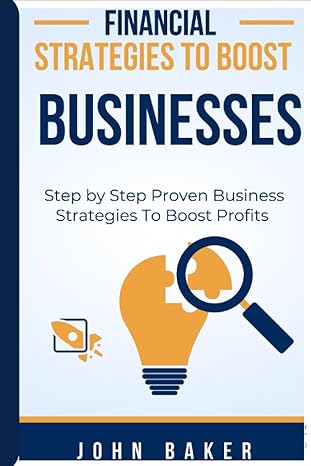Question
Question 1 Barry is a partner in Simple Solutions, Inc.. Barry's share of the partnership income is $18,600 and his average partnership equity is $155,000.
Question 1
Barry is a partner in Simple Solutions, Inc.. Barry's share of the partnership income is $18,600 and his average partnership equity is $155,000. His partner return on equity equals 8.33.
True
False
5 points
Question 2
A payroll register usually shows the pay period dates, hours worked, gross pay, deductions, and net pay of each employee for every pay period.
True
False
5 points
Question 3
Sellers allow customers to use credit cards:
| To avoid having to evaluate a customer's credit standing for each sale. | ||
| To lessen the risk of extending credit to customers who cannot pay. | ||
| To speed up receipt of cash from the credit sale. | ||
| To increase total sales volume. | ||
| All of these. |
5 points
Question 4
Known liabilities:
| Include accounts payable, notes payable, and payroll. | ||
| Are obligations set by agreements, contracts, or laws. | ||
| Are measurable. | ||
| Are definitely determinable. | ||
| All of these. |
5 points
Question 5
All of the following statements regarding liabilities are True except:
| A liability is a probable future payment of assets or services. | ||
| Unearned future wages to be paid to employees should be recorded as liabilities. | ||
| For a liability to be reported, it must be a present obligation that results from a past transaction or event, and requires a future payment of assets or services. | ||
| Information about liabilities is more useful when the balance sheet identifies them as either current or long term. | ||
| All of these are True. |
5 points
Question 6
Obligations not due within one year or the company's operating cycle, whichever is longer, are reported as current liabilities.
True
False
5 points
Question 7
A patent:
| Gives its owner the exclusive right to publish and sell a musical or literary work during the life of the creator plus 70 years. | ||
| Gives its owner an exclusive right to manufacture and sell a patented item or to use a process for 20 years. | ||
| Gives its owner an exclusive right to manufacture and sell a device or to use a process for 50 years. | ||
| Is the amount by which the value of a company exceeds the fair market value of a company's net assets if purchased separately. | ||
| Gives its owner the exclusive right to publish and sell a musical or literary work during the life of the creator plus 17 years. |
5 points
Question 8
A corporation was formed on January 1. The corporate charter authorized 100,000 shares of $10 par value common stock. During the first month of operation, the corporation issued 300 shares to its attorneys in payment of a $5,000 charge for drawing up the articles of incorporation. The entry to record this transaction would include:
| A debit to Organization Expenses for $3,000. | ||
| A debit to Organization Expenses for $5,000. | ||
| A credit to Common Stock for $5,000. | ||
| A credit to Paid-in Capital in Excess of Par Value, Common Stock for $5,000. | ||
| A debit to Paid-in Capital in Excess of Par Value, Common Stock for $2,000. |
5 points
Question 9
Adam is paid on a monthly basis. For the month of January of the current year, he earned a total of $8,288. FICA tax for Social Security is 6.2% and the FICA tax for Medicare is 1.45%. The FUTA tax rate is 0.6%, and the SUTA tax rate is 5.4%. Both unemployment taxes are applied to the first $7,000 of an employee's pay. The amount of Federal Income Tax withheld from his earnings was $1,375.17. What is the amount of the employer's payroll taxes expenses for this employee?
| $2009.21 | ||
| $1131.31 | ||
| $2506.48 | ||
| $1054.04 |
5 points
Question 10
The total amount of cash and other assets received by a corporation from its stockholders in exchange for its stock is:
| Always equal to its par value. | ||
| Always equal to its stated value. | ||
| Referred to as paid-in capital. | ||
| Referred to as retained earnings. | ||
| Always below its stated value. |
5 points
Question 11
A potential lawsuit claim is recorded when the claim can be reasonably estimated and it is reasonably possible.
True
False
5 points
Question 12
A company can have a liability even if the amount of the obligation is unknown.
True
False
Step by Step Solution
There are 3 Steps involved in it
Step: 1

Get Instant Access to Expert-Tailored Solutions
See step-by-step solutions with expert insights and AI powered tools for academic success
Step: 2

Step: 3

Ace Your Homework with AI
Get the answers you need in no time with our AI-driven, step-by-step assistance
Get Started


